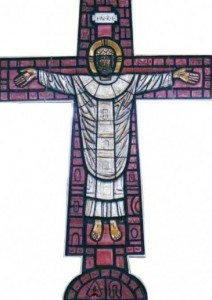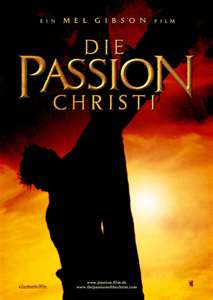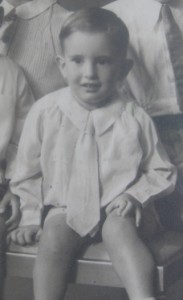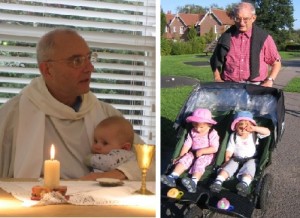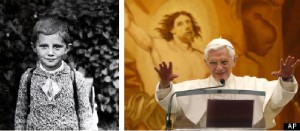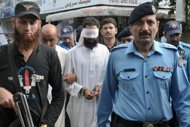This week I would like to discuss the concepts of priesthood, in particular, my understanding of the ‘Royal Priesthood’ – ‘… a chosen generation, a royal priesthood, an holy nation … that you should show forth the praises of him who called you …. ’ (1 Peter 2:9), and also that of the Ordained Priesthood. All this links closely with our new Presidential Chair in Church, of which a close up picture is shown below:
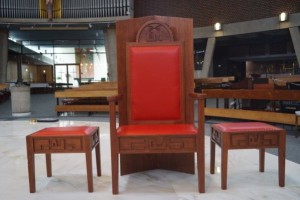 |
When I entered the monastic community of Ampleforth Abbey, in September 1961, I did so because I thought God was calling me to the priesthood. I soon discovered that I had entered a monastery, and that monastic life did not emphasise, primarily, the importance of priestly ordination; rather it seemed to emphasise my response to God’s call, out of his immense love for me, to give myself to him as a monk. This was formalised in the vows I took as a monk. I discovered, also, that monks who were ordained priests, did not act, necessarily, more virtuously than monks who were not ordained. We then had no ‘lay brothers’ – all trained monks at Ampleforth were ordained priests – but I met other brothers, in Religious Life, who were often more ‘rounded’ human beings than some priests. In any case, I could observe with my own eyes how people behaved, and all in our monastery are, first and foremost, men with all the good, and less good characteristics they possessed before becoming ordained.
In January 1973 I was sent for a short ‘stint’ to St. Mary’s, Warrington, for my first parochial experience. There, for the first time, I began to see how the people of God – the ‘Royal Priesthood’ – esteemed we ordained priests so highly in their regard; I asked myself why this should be, and to this, my conclusions are:
- They love their priests, if they are kind and do their duty, because priests help them in important personal and family times.
- The Ordained Priest is a direct link with God because he consecrates Bread and Wine at Mass and has the power to forgive sin. He is, therefore, a channel bringing grace to the people, through the sacraments.
- He is not married – save to God – and so is a ‘man apart’, having time to spend in prayerful studying, and time each day, in union with the one each Christian person is meant to make the centre of their lives: God.
- The priest is meant to be a true shepherd and lead people to know God and his Love – a task he can only perform if, truly, he is a man of God, a man of Love.
My instinct has always been to see myself as, essentially, a member of the ‘One Body of Christ’, but with a special function as a priest. I hasten to add, however, that this special function does not mean I am ‘better’ or ‘more worthy’ or ‘more holy’ than my brothers and sisters in the Community of Faith. In fact, each baptised person is, potentially, a priest, prophet and king, as is stated in the Baptismal Rite. True, a lay person is not an ordained priest, but each Christian can be a person acting as a ‘bridge’ between God and humanity, which is exactly like the role of a priest. I have always liked to see the priest as ‘servant of all’, just like Jesus, who washed the feet of the apostles at the Last Supper.
But, to return to the subject of the newly aquired Presidential Chair, in our Church. Below, is a photograph showing it in relationship to the ambo and the altar. Those who are involved in the Art and Architecture Department of our Diocese felt that we, in Leyland, had one omission – one piece missing – in the re-ordering of our Church, that has taken place during the past few years. That essential missing piece was a ‘Presidential Chair’, designed to give due honour to the office of the priesthood.
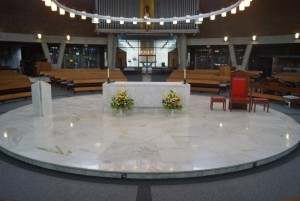 |
I have to say that much careful thought was exercised over this, and it took a relatively long time for the authorities to agree a design they thought worthy of the Church; ultimately, the finished piece has been made by the ‘Mouse Man’ of Kilburn, Yorkshire – the firm that produced the benches for our Church – and other major wooden accoutrements. Just as our forefathers wanted the best for our building, so the authorities agreed that we should have the same quality for this, uniquely, important feature of the sanctuary.
 |
Wood Carving Detail – Back of the Presidential Chair
Since its positioning, I have found that this new Presidential Chair, now in use, has caused me to reflect a little, on a number of aspects. It is now one of the three ‘major features’ on the altar, whereas its predecessor – a much smaller chair – was somehow ‘lost’ in the scheme of things. It makes me see the importance of the ‘office’ of the ordained priest, in that he really does represent Jesus in the liturgy, for the congregation. However, it must be noted that the chair does not honour the man who is the priest; rather, it honours Jesus, who is the one who leads the liturgy. The liturgy of the Church is actually the liturgy of Christ, himself, something much more important than the sum of the individuals who make up the congregation, including the person of the ordained priest. In a very profound way, it is important that the ordained priest occupying this chair should become united, as close as is possible, to Christ, for, after all, he represents Our Lord in the liturgical assembly, together with everybody else – but in a way, differently, to the congregation. The honour is given to Jesus himself, not to the individual person of the ordained priest.
So, it pleases me, greatly, that we have been given the opportunity to receive this new chair into our Church, through the generosity of individual parishioners, who gave money for this specific, and important complement to the altar; similarly, grateful thanks go to those who belong to the ‘500 Club’, because some of the money came from that source, as well.
It is fitting that the ‘Royal Priesthood’ has, in this way, honoured the ‘Ordained Priesthood’, and I hope that the Presidential Chair will remain a feature of our Parish community, for many, many years into the future. I hope, and pray, that, in time, there will be young men, and women, coming from our Community of Faith of the Royal Priesthood of Leyland St. Mary’s, willing to give themselves to God, as religious men or women, or indeed as ordained priests. May God bless you all and thank you, again.
To view in its original format, readers are advised to go to the main blog site.
